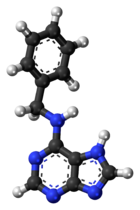
| |

| |
| Names | |
|---|---|
| Systematic IUPAC name
N-(Phenylmethyl)-7H-purin-6-amine | |
| Other names
Benzyl adenine; 6-Benzyladenine
| |
| Identifiers | |
3D model (JSmol)
|
|
| ChEBI | |
| ChEMBL | |
| ChemSpider | |
| ECHA InfoCard | 100.013.570 |
| KEGG | |
PubChem CID
|
|
| UNII | |
CompTox Dashboard (EPA)
|
|
| |
| |
| Properties | |
| C12H11N5 | |
| Molar mass | 225.255 g·mol−1 |
| Appearance | White to off-white powder |
| 0.44 g/L (15°C)[1] | |
| Hazards | |
| Safety data sheet (SDS) | External MSDS |
Except where otherwise noted, data are given for materials in their standard state (at 25 °C [77 °F], 100 kPa).
| |
6-Benzylaminopurine, benzyl adenine, BAP or BA[2] is a first-generation synthetic cytokinin that elicits plant growth and development responses, setting blossoms and stimulating fruit richness by stimulating cell division. It is an inhibitor of respiratory kinase in plants, and increases post-harvest life of green vegetables. Influence of cytokinin as 6-benzylaminopurine (BAP) in combination with other methods on postharvest green color retention on broccoli heads and asparagus spears, showed positive results for quality retention. Treatment with 10 and 15 ppm BAP can be used to extend shelf life of fresh-cut broccoli florets and shredded cabbage during storage at 6±1°C at commercial level.[3][4]
It can be used to extend the shelf life of flowers and cut greens in floristry. The shelf life of cut shoots of Polygonatum multiflorum 'Variegatum' kept in water is about 7 days. To extend their life after cutting, conditioning with gibberellic acid or BA is used. This doubles their possible use.[5]
6-Benzylaminopurine was first synthesized and tested in the laboratories of plant physiologist Folke K. Skoog.[6]
- ^ 6-Benzylaminopurine (6-BAP). (n.d.). Duchefa Biochemie. Retrieved December 10, 2022, from https://www.duchefa-biochemie.com/product/details/number/B0904
- ^ Teixeira da Silva, Jaime A. "Is BA (6-benzyladenine) BAP (6-benzylaminopurine)?". ResearchGate. Retrieved 2019-02-14.
- ^ Siddiqui, M. W.; Bhattacharjya, A.; Chakraborty, I. and Dhua, R. S. 2011. 6-benzylaminopurine improves shelf life, organoleptic quality, and health-promoting compounds of fresh-cut broccoli florets. Journal of Scientific and Industrial Research, 70 (6): 461–465.
- ^ Siddiqui, M.W.; Bhattacharjya, A. and Chakraborty, I. 2011. Maintaining organoleptic quality of minimally processed cabbage using 6-benzylaminopurine. International Symposium on System Intensification towards Food and Security, Feb. 24- 27, 2011, Kalyani, Nadia, West Bengal, India, p. 405.
- ^ Krzymińska-Bródka A, Ulczycka-Walorska M, Łysiak GP, Czuchaj P (December 2023). "The longevity of cut Polygonatum multiflorum (L.) All. shoots depending on postharvest handling". Acta Agrobotanica. 76. Polish Botanical Society: 1–11. doi:10.5586/aa/176280.
- ^ "Molecule of the Week Archive 6-Benzyladenine". 2016-04-18. Retrieved 2019-12-02.